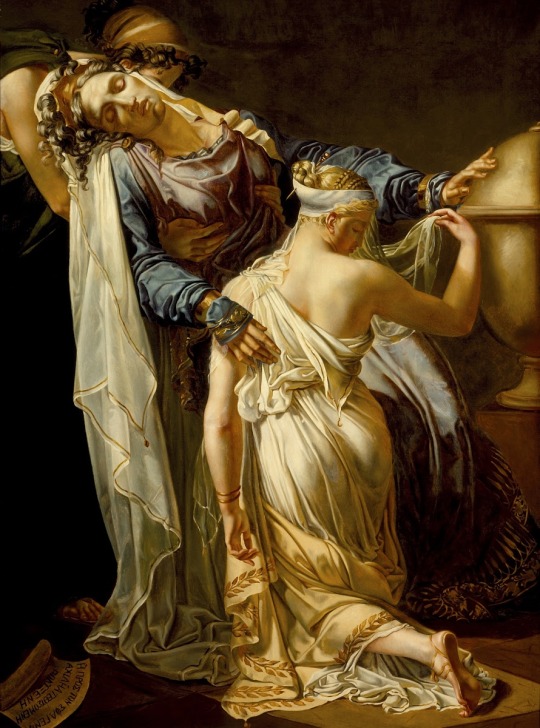#Merry-Joseph Blondel
Explore tagged Tumblr posts
Text

Portrait of Félicité-Louise de Durfort, Maréchale de Beurnonville
Artist: Merry Joseph Blondel (French, 1781-1853)
Date: 1808
Medium: Oil on Canvas
Collection: Private Collection
Description
Félicité-Louise de Durfort (1782-1870) was the youngest daughter of Count de Durfort, the pre-Revolutionary French Ambassador of France to the Republic of Venice (where died in exile in 1801). She is depicted standing in a simple high-waisted white dress, the splendid cashmere shawl draped over her right arm falling to the ground where the sun streams across it. Her hair is done in the latest fashion, while she is partially shaded by the splendid orange tree against whose large, painted wooden pot she is leaning. To the left we see some steps leading down to a winding path with a distant view of the Château of Balincourt.
#portrait#female#full length#standing#oil on canvas#fine art#painting#woman#high waisted dress#cashmere shawl#orange tree#wooden pot#steps#path#chateau balincourt#garden#merry joseph blondel#french painter#flowers#19th century painting
27 notes
·
View notes
Text

Raymond IV of Toulouse by Merry-Joseph Blondel
#raymond iv of toulouse#raymond iv#first crusade#art#merry joseph blondel#salles des croisades#crusades#crusader#crusaders#crusade#medieval#middle ages#history#europe#european#france#versailles#toulouse#tripoli#christianity#christian#christendom
84 notes
·
View notes
Text

Merry-Joseph Blondel, La mort de Hyacinthe, 1810
26 notes
·
View notes
Photo

Moses von Merry Joseph Blondel (1828, Öl auf Leinwand)
#kunst#kunstwerk#art#artwork#merry joseph blondel#artist#künstler#religion#religiöse kunst#religious art#moses#mose#mann#man#bibel#bible#glaube#faith#holy#heilig#gott#god#vater#father#herr#lord#beten#pray#portrait#porträt
8 notes
·
View notes
Photo
The message of peace being more imperative than ever. Are external disputes caused solely by external matters, or are they a product of internal battles that humanity often denies, neglects to see so to make an effort to heal? For the wise ones, the answer is obvious. How can we talk of progress if that progress is only technological while our ethics suffer? Has human consciousness evolved the way it could? Of course there are many directions on this earth, from low instincts to uplifted spirits, this is the realm of contradictions, but if only mainstream media had less power and the power of the heart became increased...

No, but like an honest woman, show thyself to thy worshippers, who are worn with regretting thee all these thirteen years. Hush the noise of battle, be a true Lysimacha to us. Put an end to this tittle-tattle, to this idle babble, that set us defying one another. Cause the Greeks once more to taste the pleasant beverage of friendship and temper all hearts with the gentle feeling of forgiveness. Peace by Aristophanes. Peace by Merry Joseph Blondel
#aristophanes#ancient greek literature#peace#symbolism#merry joseph blondel#art#ειρήνη#humanity#world affairs
263 notes
·
View notes
Text

The Death of Hyacinthus c.1830 by Merry-Joseph Blondel (1781-1853)
165 notes
·
View notes
Text

“Portrait of Maréchal de Bourdillon" by Merry-Joseph Blondel (1781–1853). French historical painter. Château de Versailles, FR. oil on canvas
256 notes
·
View notes
Text

BLONDEL, Merry-Joseph Portrait of Félicité-Louise de Durfort, Maréchale de Beurnonville 1808 Oil on canvas, 194 x 130 cm Private collection
131 notes
·
View notes
Text

Death of Hyacinthus
By Merry Joseph Blondel
55 notes
·
View notes
Text

Merry-Joseph Blondel, 1781-1853
Aeneas becomes a God, ca.1820, oil on canvas, 127x96 cm
Museo Nacional del Prado, Madrid Inv. P006075
According to the fourteenth book of Ovid’s Metamorphoses, after ordering the river Numicius to wash away all the mortal aspect of Aeneas, Venus anointed him with a divine perfume and touched his mouth with a mixture of ambrosia and nectar, thus transforming him into a god (Miguel Ángel Hernanz Santos, information provided to the Museum in March 2021). Blondel, who specialised in decorative schemes for buildings, was a notable representative of Neo-classicism in France. (Museo del Prado)
48 notes
·
View notes
Text

Merry-Joseph Blondel (1781-1853), Portrait d'homme, 1835, coll. part.
19 notes
·
View notes
Text

Merry-Joseph Blondel
Hecuba and Polyxena ( after 1814 )
231 notes
·
View notes
Text

'Alcestis and Admetus'. Merry Joseph Blondel. 1828.
19 notes
·
View notes
Text

The Death of Hyacinthus
by Merry-Joseph Blondel
6 notes
·
View notes
Text

Hecuba and Polyxena
Artist: Merry-Joseph Blondel (French, 1781-1853)
Date: After 1814
Medium: Oil on canvas
Collection: Los Angeles County Museum of Art, Los Angeles, CA, United States
Description
This painting was inspired by the horrific plight of the royal family of Troy after the mythical Trojan War. Men of the Trojan royal family were massacred during and after the war - including King Priam and his most famous sons, Hector, Paris, Polydorus and Lycaon.
Priam and Hecuba’s youngest son, Polydorus, also met a violent end, as he was assassinated by his treacherous guardian, King Polymestor of Thrace, who killed the young prince when he learned of the fall of Troy. Meanwhile, Queen Hecuba and the princesses of Troy - including Cassandra and Polyxena - were captured and enslaved by the Greek forces.
#mythological art#greek mythology#hecuba#polysena#mythology#trojan war#mythological characters#mythological scene#royal family of troy#polyxena#female figures#drapery#urn#queen hecuba#princess of troy#painting#oil on canvas#fine art#oil painting#french culture#french art#merry joseph blondel#french painter#european art#19th century painting#los angeles county museum of art
6 notes
·
View notes
Text

The Death of Hyacinthus
Merry-Joseph Blondel; date unknown (18th - 19th century)

The Death of Hyacinthus
Jean Broc; 1801
#dark academia#dark acadamia aesthetic#light academia#light academic aesthetic#chaotic academia#art#painting#19th century#19th century art#18th century#18th century art#hyacinth#hyacinthus#the death of hyacinthus#death of hyacinthus#19th painting#18th painting#art academia#greek mitology#greek myth art#apollo#apollo and hyacinthus#marry-joseph blondel#jean broc
39 notes
·
View notes